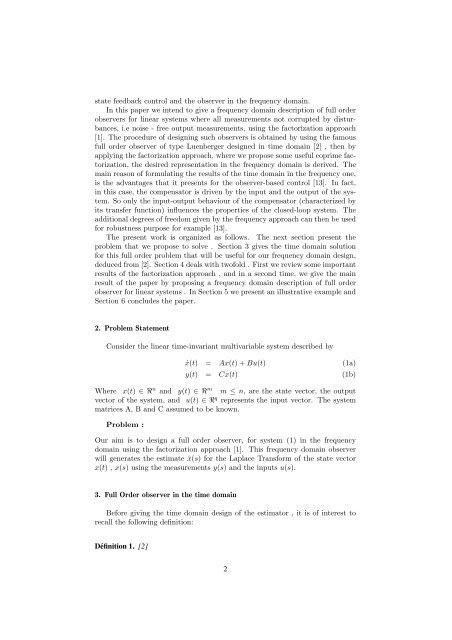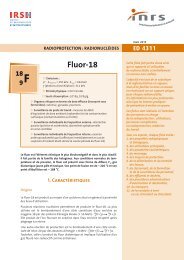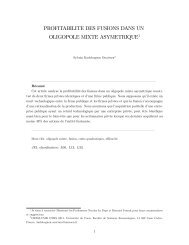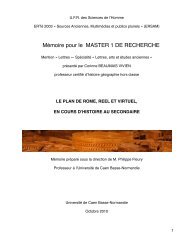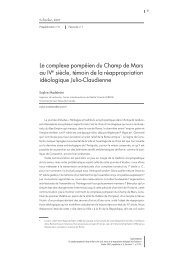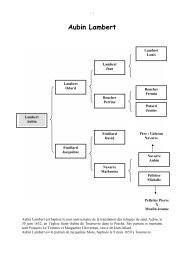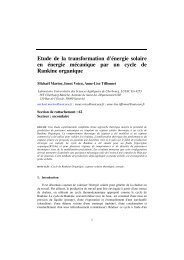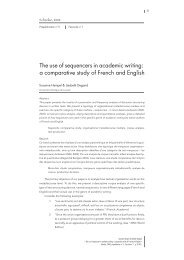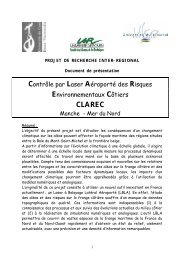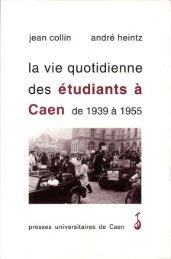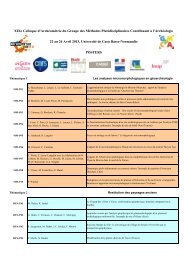Frequency domain design of observers for linear systems using a ...
Frequency domain design of observers for linear systems using a ...
Frequency domain design of observers for linear systems using a ...
Create successful ePaper yourself
Turn your PDF publications into a flip-book with our unique Google optimized e-Paper software.
state feedback control and the observer in the frequency <strong>domain</strong>.<br />
In this paper we intend to give a frequency <strong>domain</strong> description <strong>of</strong> full order<br />
<strong>observers</strong> <strong>for</strong> <strong>linear</strong> <strong>systems</strong> where all measurements not corrupted by disturbances,<br />
i.e noise - free output measurements, <strong>using</strong> the factorization approach<br />
[1]. The procedure <strong>of</strong> <strong>design</strong>ing such <strong>observers</strong> is obtained by <strong>using</strong> the famous<br />
full order observer <strong>of</strong> type Luenberger <strong>design</strong>ed in time <strong>domain</strong> [2] , then by<br />
applying the factorization approach, where we propose some useful coprime factorization,<br />
the desired representation in the frequency <strong>domain</strong> is derived. The<br />
main reason <strong>of</strong> <strong>for</strong>mulating the results <strong>of</strong> the time <strong>domain</strong> in the frequency one,<br />
is the advantages that it presents <strong>for</strong> the observer-based control [13]. In fact,<br />
in this case, the compensator is driven by the input and the output <strong>of</strong> the system.<br />
So only the input-output behaviour <strong>of</strong> the compensator (characterized by<br />
its transfer function) influences the properties <strong>of</strong> the closed-loop system. The<br />
additional degrees <strong>of</strong> freedom given by the frequency approach can then be used<br />
<strong>for</strong> robustness purpose <strong>for</strong> example [13].<br />
The present work is organized as follows. The next section present the<br />
problem that we propose to solve . Section 3 gives the time <strong>domain</strong> solution<br />
<strong>for</strong> this full order problem that will be useful <strong>for</strong> our frequency <strong>domain</strong> <strong>design</strong>,<br />
deduced from [2]. Section 4 deals with tw<strong>of</strong>old . First we review some important<br />
results <strong>of</strong> the factorization approach , and in a second time, we give the main<br />
result <strong>of</strong> the paper by proposing a frequency <strong>domain</strong> description <strong>of</strong> full order<br />
observer <strong>for</strong> <strong>linear</strong> <strong>systems</strong> . In Section 5 we present an illustrative example and<br />
Section 6 concludes the paper.<br />
2. Problem Statement<br />
Consider the <strong>linear</strong> time-invariant multivariable system described by<br />
ẋ(t) = Ax(t)+Bu(t) (1a)<br />
y(t) = Cx(t) (1b)<br />
Where x(t) ∈ n and y(t) ∈ m m ≤ n, are the state vector, the output<br />
vector <strong>of</strong> the system, and u(t) ∈ q represents the input vector. The system<br />
matrices A, B and C assumed to be known.<br />
Problem :<br />
Our aim is to <strong>design</strong> a full order observer, <strong>for</strong> system (1) in the frequency<br />
<strong>domain</strong> <strong>using</strong> the factorization approach [1]. This frequency <strong>domain</strong> observer<br />
will generates the estimate ˆx(s) <strong>for</strong> the Laplace Trans<strong>for</strong>m <strong>of</strong> the state vector<br />
x(t) ,x(s) <strong>using</strong> the measurements y(s) and the inputs u(s).<br />
3. Full Order observer in the time <strong>domain</strong><br />
Be<strong>for</strong>e giving the time <strong>domain</strong> <strong>design</strong> <strong>of</strong> the estimator , it is <strong>of</strong> interest to<br />
recall the following definition:<br />
Définition 1. [2]<br />
2


